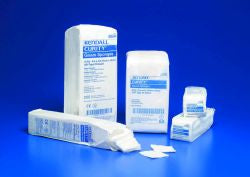Wound Care Products: About Gauzes and Tapes
With large or poorly healing wounds, wound care products, such as gauze and medical tape provide much better coverage than standard bandages.
About Gauzes: Gauzes are primarily available in two forms, gauze rolls and gauze sponges or pads. Usually, organizations that purchase gauzes in bulk opt for the rolls. However, there’s no mandatory rule that gauze rolls are meant just for bulk use and gauze sponges are applicable for sporadic use. Many people also find the rolls to be advantageous as they can be cut to fit odd shaped wounds perfectly. Sponges are more often used in sterile settings and are typically square with differing sizes and thickness, referred to as “ply”.
What makes gauzes different from regular sheets of cloth? Gauzes, unlike regular cloth, are loosely woven. This loose weave provides this fabric with a lightweight, delicate, yet durable and absorbable structure. The most common weave type used for making gauzes is leno or doup weave. This weave type enables light and air to penetrate easily through gauzes. Cotton is another common raw material used for making this wound care product. You will also see gauzes made from other materials such as wool, linen, and silk. Each has a unique feel and purpose dependent on the wound being covered.
Standard gauze rolls and sponges come in solid colors. However, you will also come across brands offering patterned, stretched, and crinkled variations. Patterned gauzes are used in pediatrics; children are more compliant with covering wounds when fun colors are used.
When it comes to wound care, why are gauzes the most used option? It’s simply because gauzes are capable of absorbing more liquid than the majority of the fabric types of wound covers available on the market.
Medical tapes: Use of medical tapes is also common both in homes and medical facilities such as hospitals, clinics and nursing homes. Below we have listed the different types of medical tapes you will find when searching for wound care items. The classification is done based on the materials used for making the product and the application.
- Tapes made of paper are meant for light dressings. Removing them is extremely easy as they adhere to the skin very lightly. It’s a good option even for people with extremely sensitive skin, for instance, elderly individuals and small children.
- Fabric tapes: Fabric tapes are made of taffeta, cotton, polyester or a blend of different fibers. They are extremely flexible and strong and can be stretched for covering large areas. They are great options for wounds in awkward body parts such as biceps, which contract and expand with movement.
- Plastic tapes: They are often perforated and as a result allow the wound to come in contact with air. The perforation also allows easy evaporation of moisture. Plastic medical tapes are much stronger than paper tapes and are perfect options for holding heavier dressings. It’s true that as a result of being perforated, most plastic tapes can be torn pretty easily; however, there are some that require to be cut using scissors.
- Foam tapes: They are thick and heavily cushioned and are the sturdiest medical tapes available on the market. They are strong enough for holding heavy compression dressing in place. These medical tapes are highly stretchy in nature and thus can keep dressings in awkward areas such as bend of elbows and knees in position. They cannot be cut easily; to work with foam tapes, you will need to use sharp scissors.


